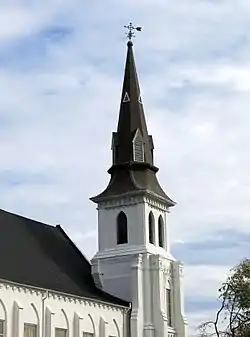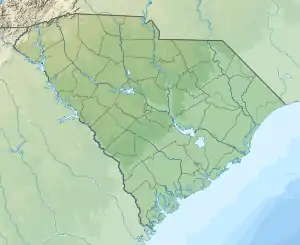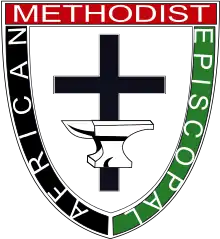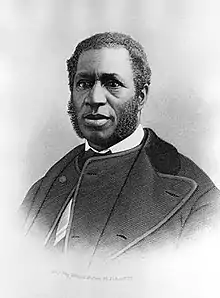Emanuel African Methodist Episcopal Church
The Emanuel African Methodist Episcopal Church, often referred to as Mother Emanuel, is a church in Charleston, South Carolina. Founded in 1817, Emanuel AME is the oldest African Methodist Episcopal church in the Southern United States. This first independent black denomination in the United States was founded in 1816 in Philadelphia, Pennsylvania.
| Emanuel AME Church | |
|---|---|
| "Mother Emanuel" African Methodist Episcopal Church | |
 | |
 Emanuel AME Church  Emanuel AME Church | |
| 32°47′14″N 79°55′59″W | |
| Location | Charleston, South Carolina |
| Country | United States |
| Denomination | African Methodist Episcopal Church |
| Membership | 1600 (2008) |
| Website | motheremanuel.com |
| History | |
| Status | Church |
| Founded | 1816 |
| Founder(s) | Rev. Morris Brown Denmark Vesey |
| Architecture | |
| Functional status | Active |
| Architect(s) | John Henry Deveraux |
| Style | Gothic Revival |
| Groundbreaking | 1891 |
| Specifications | |
| Capacity | 2500 |
| Number of spires | 1 |
| Administration | |
| Parish | African Methodist Episcopal Church |
| District | Seventh |
| Clergy | |
| Bishop(s) | Richard Franklin Norris |
| Senior pastor(s) | Rev. Eric S.C. Manning |
 | |
Emanuel African Methodist Episcopal Church | |
| Location | Charleston, South Carolina |
| Architect | John Henry Deveraux |
| Part of | Charleston Historic District (ID66000964[1]) |
| NRHP reference No. | 100003056 |
| Significant dates | |
| Added to NRHP | October 25, 2018 |
| Designated NHLDCP | October 15, 1966 |
Mother Emanuel has one of the oldest black congregations south of Baltimore.[2] Black Baptist churches were founded in South Carolina and Georgia before the American Revolutionary War.
History
History and foundation
In the late eighteenth and early nineteenth century Great Awakenings, Baptist and Methodist missionaries had evangelized among both enslaved and free African Americans in the South, as well as whites. Blacks were welcomed as members of the new churches and some leaders were licensed as preachers. But the white-dominated churches generally maintained control of their institutions and often relegated blacks to segregated galleries or separate services, scheduled at alternative times or in such locations as church basements. State law and city ordinance required lawful churches to be led by whites. African-American members, most of whom were enslaved, were allowed to hold separate services in those churches, usually in the basements.
In Charleston in the nineteenth century, the white-dominated churches had increasingly discriminated against blacks. A dispute arose after white leaders of Bethel Methodist authorized construction of a hearse house over its black burial ground.[3] Black congregants were outraged.
In 1818 church leader Morris Brown left this church in protest. Nearly 2,000 Black members from the city's three Methodist churches soon followed him to create a new church.[4]
They founded a church known first as the Hampstead Church on Reid and Hanover streets.[5] (Dates of founding have been given as 1816, when the national denomination was founded,[6] 1817,[7] when Morris Brown traveled to Philadelphia to meet with Allen and other founders, and was ordained as a deacon, or 1818.)[8]
The congregation was made up of African Americans who were former members of Charleston's three Methodist Episcopal churches.[9] Hampstead Church was considered part of the "Bethel circuit" of the African Methodist Episcopal Church, the newly established, first independent black denomination in the United States. It was founded in 1816 in Philadelphia, Pennsylvania by Richard Allen and delegates from some other black churches.
State and city ordinances at the time limited worship services by black people to daylight hours, required that a majority of congregants in a given church be white, and prohibited black literacy. In 1818, Charleston officials arrested 140 black church members and sentenced eight church leaders to fines and lashes. City officials again raided Emanuel AME Church in 1820 and 1821 in a pattern of harassment.[7]
In June 1822, Denmark Vesey, one of the church's founders, was implicated in a slave revolt plot. Vesey and five other organizers were rapidly convicted, and executed on July 2 after a secret trial.[10]
The city conducted additional trials over the following weeks, as the number of suspects increased while men were interrogated. They ultimately convicted and executed more than 30 men, and deported other suspected participants from the state, including Vesey's son. The original Emanuel AME church was burned down that year by a crowd of angry whites.[2][3][11] After the congregation met secretly for a period, it rebuilt the church after the Civil War.[12][13]
Rev. Morris Brown was imprisoned for many months, though never convicted of any crime. Upon his release, he and several other prominent members fled to Philadelphia, Pennsylvania. Others managed to reconstitute the congregation in a few years.
In reaction to Nat Turner's slave rebellion of 1831, in 1834 the white-run city of Charleston outlawed all-black churches. The AME congregation met in secret until the end of the Civil War in 1865.[14][15]
After the Civil War

After the war ended, AME Bishop Daniel Payne installed the Reverend Richard H. Cain as the pastor of the congregation that would become Emanuel ("God with us") AME and Morris Brown AME[16] In 1872, after serving in the South Carolina Senate (1868–72), Cain was elected as a Republican Congressman in the U.S. House of Representatives, continuing a tradition of religious leaders serving in political positions.[17]
The congregation rebuilt the church between 1865 and 1872 as a wooden structure,[18] under the lead of the architect Robert Vesey, the son of abolitionist and church co-founder Denmark Vesey.[7] After an earthquake demolished that building in 1886,[3] President Grover Cleveland donated ten dollars to the church to aid its rebuilding efforts. He wrote that he was "very glad to contribute something for so worthy a cause."[19] A Democrat, Cleveland also donated 20 dollars to the Confederate Home, a "haven for white widows."[20]
The current brick and stucco building was constructed in 1891 on Calhoun Street.[21] This and other post-Civil War black churches were built on the north side of Calhoun Street.[22] Blacks were not welcome on the south side of what was known as Boundary Street when the church was built.[23] The building was designed by leading Charleston architect John Henry Devereux; the work was begun in the spring of 1891 and completed in 1892.[24]
20th century
In March 1909, Booker T. Washington, president of Tuskegee Institute and a national leader, spoke at Emanuel AME Church.[25] Among the attendees were many whites, including a member of the Supreme Court of Pennsylvania and Robert Goodwyn Rhett, the mayor of Charleston; he was a lawyer and controlling owner of the News and Courier newspaper.
By 1951, the church had 2,400 members and completed a $47,000 ($463 thousand in 2019 dollars[26]) renovation project. This earned an "outstanding improvement" award from the Charleston Chamber of Commerce.[27]
At a 1962 church meeting, Reverends Martin Luther King Jr. and Wyatt T. Walker of the Southern Christian Leadership Conference were guest speakers, urging church members to register and vote.[28] At the time, most African Americans in the South were still disenfranchised, which they had been since the turn of the century when the white-dominated legislatures passed restrictive conditions raising barriers to voter registration in new constitutions and laws. In 1969 Coretta Scott King, then widowed after King's assassination, led a march of some 1,500 demonstrators to the church in support of striking hospital workers in Charleston.[29] At the church, they faced bayonet-wielding members of the South Carolina National Guard; the church's pastor and 900 demonstrators were arrested.[30]
The church building was damaged in Hurricane Hugo in 1989.[18] Although major repairs were made, the tin roof soon rusted and leaked. It was changed out for interlocking copper shingles.[31]
21st century
As of 2008, the church had more than 1,600 members and assisted the Charleston Interfaith Crisis Ministry and other charities.[32] The church is involved in the local arts community, including hosting an art show in 2013 and concerts by the Charleston Symphony Orchestra Gospel Choir.[33]
In 2010, senior pastor and state senator Rev. Clementa Pinckney was noted as following in the tradition of earlier church leaders, such as the Reverend Richard H. Cain of the 19th century, in serving as both a religious and political leader.[34]
On December 31, 2012, the church held a watchnight service; they celebrated the 150th anniversary of the Emancipation Proclamation, which was issued on January 1, 1863.[35] Charleston's annual Emancipation Day Parade on January 1 ends at Emanuel AME Church.[36][37][38]
2015 shooting
On June 17, 2015, nine people were shot and killed inside Mother Emanuel. The victims included South Carolina State Senator Clementa Pinckney, senior pastor; Cynthia Hurd, Depayne Middleton-Doctor, Sharonda Coleman-Singleton, Susie Jackson, Myra Thompson, Tywanza Sanders, Ethel Lance, and Daniel Simmons. Dylann Roof, a 21-year-old white male, was arrested shortly afterward and charged with nine counts of murder. The killings were investigated by state and federal law enforcement officials as a possible hate crime, and it was found that they were.[39] Pinckney, as well as eight congregation members, were killed in the attack.[40] According to the FBI, Roof left a manifesto detailing his racist views on the lastrhodesian.com website before the shooting.[41][42]
The Rev. Dr. Norvel Goff, Sr. served as the interim pastor from June 17, 2015, until early 2016.[43] On January 23, 2016, The Rev. Dr. Betty Deas Clark, was appointed pastor. She is the first woman to lead the congregation in its 200-year existence.
Building
Built in 1891, Emanuel AME Church has one of the few well-preserved historic church interiors in the area, with original features including the altar, communion rail, pews, and light fixtures.[44] In December 2014, the church publicized fundraising to build an elevator to make the building more accessible.[44] A pipe organ was installed in 1902.[18] The church has a capacity of 2,500, making it among Charleston's largest black churches.[18] It was listed on the National Register of Historic Places in 2018.[45]
In 2014 the building was determined to suffer from termite infestation, which had resulted in "severe structural deterioration." The church received a $12,330 federal historic preservation grant from the state of South Carolina to complete a structural investigation in May 2014.[46]
Documentary
A producer of a documentary film, The AME Movement: African Methodism in South Carolina, that describes the history of the AME church movement in South Carolina, held a Kickstarter fundraising campaign in 2013, but failed to reach his goal. Various interviews were conducted and filmed for the documentary.[47][48]
References in literature
Tyehimba Jess's book Olio (2015) mentions both the 1822 burning of the church and the 2015 shooting. The book of poetry and music begins and ends, respectively, with these events.
References
- "Old and Historic Charleston (Extend)". National Park Service. Department of the Interior. Retrieved June 18, 2015.
- Weisman, Jonathan (June 18, 2015). "Killings Add a Painful Chapter to Storied History of Charleston Church". The New York Times. Retrieved June 18, 2015.
- Curtis, Nancy C. (1996). Black Heritage Sites: An African American Odyssey and Finder's Guide. Chicago: American Library Association. p. 195. ISBN 978-0-838-90643-9. OCLC 45885630.
- Yee, Shirley. "Brown, Morris (1770–1849)". BlackPast.org. BlackPast.org. Retrieved June 17, 2015.
- Robertson, David M. (1999), Denmark Vesey: The Buried Story of America's Largest Slave Rebellion and the Man who Led It, New York: Alfred A. Knopf, p. 45, ISBN 9780307483737.
- "'Mother Emanuel' A.M.E. Church History", Official website, Charleston: Emanuel African Methodist Episcopal Church, 2016, archived from the original on June 20, 2012.
- Egerton, Douglas R. (June 18, 2015). "The Long, Troubled History of Charleston's Emanuel AME Church". The New Republic. ISSN 0028-6583. Retrieved June 18, 2015.
- "Row over Statue to Bermudian's Slave", Bernews, January 3, 2011.
- Hardy, Rachel (2011). "The African Methodist Episcopal Church in Charleston, South Carolina: From the "Invisible Institution" to the Indivisible Institution A Walking Tour" (PDF). Program in the Carolina Lowcountry and Atlantic World (CLAW). College of Charleston. Archived from the original (PDF) on June 18, 2015. Retrieved June 18, 2015.
- Kennedy, Lionel Henry; Parker, Thomas (1822). An Official Report of the Trials of Sundry Negroes Charged with an Attempt to Raise an Insurrection in the State of South-Carolina Preceded by an Introduction and Narrative and, in an Appendix, a Report of the Trials of Four White Persons on Indictments for Attempting to Excite the Slaves to Insurrection. Charleston [S.C.]: Printed by J.R. Schenck. OCLC 765819289. Archived from the original on February 12, 2017. Retrieved June 22, 2015.
- Staff (June 18, 2015). "Nine shot, multiple fatalities reported in downtown church shooting". The Post and Courier. Retrieved June 18, 2015.
- "US: at least 9 killed in Charleston church massacre". Euronews. June 16, 2015.
- Payne, Ed (June 18, 2015). "Charleston church shooting: Multiple fatalities in South Carolina, source says". CNN. Retrieved June 18, 2015.
- "Emanuel African Methodist Episcopal Church". Reconstruction: The Second Civil War. PBS. December 19, 2013. Retrieved June 17, 2015.
- "Mother Emanuel, Charleston, SC". 7th District AME Church, South Carolina. 7th District AME Office. Archived from the original on June 18, 2015. Retrieved June 17, 2015.
- Nicklass, Karen (October 19, 2013). "National Register of Historic Places Registration Form: Old Bethel African Methodist Episcopal Church". Retrieved June 18, 2015.
- Peabody, Alvin (March 23, 1994). "Filling The Void: Young Ministers Seek To Replace Former Powerful Clergymen". Washington Informer. Washington, D.C.: 36. ISSN 0741-9414. ProQuest 367988324.
- McCaffrey, Scott (August 27, 1995). "Charleston Churches Endure - They Have Kept the Faith Through Natural Disasters and 2 Wars". Myrtle Beach Sun News.
- "Helping to Rebuild Churches: President Cleveland Sends Money to a Colored Pastor". Atlanta Constitution. October 27, 1886.
- Susan Millar Williams and Stephen G. Hoffus, Upheaval in Charleston: Earthquake and Murder on the Eve of Jim Crow, University of Georgia Press, 2011: 158.
- "Emanuel AME Church". nps.gov. Retrieved June 18, 2015.
- "Google street view photo of Calhoun Street in Charleston, showing the Emanuel AME Church, and Google map". geographic.org/streetview. Retrieved January 17, 2016.
- Samuel, Terence (October 27, 2003). "A New Political Gospel". U.S. News and World Report.
- "Perhaps the Best in the South". News and Courier. Charleston, South Carolina. December 1, 1891. p. 8. Retrieved July 10, 2015.
- David H. Jackson Jr., "Booker T. Washington in South Carolina, March 1909." The South Carolina Historical Magazine 113.3 (July 2012): 192-220.
- Federal Reserve Bank of Minneapolis. "Consumer Price Index (estimate) 1800–". Retrieved January 1, 2020.
- "Historic Landmark in Charleston". The Afro-American (Baltimore). March 10, 1951.
- "King vote team hits Charleston". The Afro-American (Baltimore). April 21, 1962.
- Golphin, Bruce (April 30, 1969). "Mrs. King to Lead Charleston March: Nixon Urged to Act In Charleston Strike". The Washington Post.
- Keneally, Meghan (June 18, 2015). "Charleston South Carolina Church Where 9 Were Killed Was Steeped in History". ABC News. Retrieved June 18, 2015.
- Behre, Robert (October 28, 1998). "A man at the peak of his performance". The Post and Courier.
- Fox, William Price; McLaughlin, J. Michael (2008). "South Carolina: A Guide to Unique Places". South Carolina : Off the Beaten Path. Globe Pequot: 23–24. ISSN 1545-5130.
- Pandolfi, Elizabeth (September 25, 2013). "African-American artists find a home at Emanuel AME Church". Charleston City Paper. Retrieved June 18, 2015.
- Parker, Adam (November 28, 2010). "Mother Emanuel AME pastor follows in footsteps of 19th-century minister-lawmaker". The Post and Courier. Archived from the original on June 18, 2015. Retrieved June 18, 2015.
- McLeod, Harriet (January 1, 2013). "Watch Night marks 150th anniversary of Lincoln's proclamation". Reuters. Retrieved June 18, 2015.
- Kropf, Schuyler (January 1, 2013). "Charleston Emancipation Proclamation Parade is today". The Post and Courier. Archived from the original on June 18, 2015. Retrieved June 18, 2015.
- "Parade marks 151 years since Emancipation Proclamation signing". ABC News 4. January 2, 2014. Retrieved June 18, 2015.
- Munday, Dave (January 1, 2015). "Charleston's Emancipation Day Parade has a long and colorful history". The Post and Courier. Archived from the original on January 5, 2015. Retrieved June 18, 2015.
- Bever, Lindsey; Costa, Robert (June 17, 2015). "9 dead in shooting at historic Charleston African American church". The Washington Post. Retrieved June 18, 2015.
- Johnson, M. Alex (June 17, 2015). "'This Was a Hate Crime': Nine People Killed at Historic South Carolina Church". NBC News. Retrieved June 18, 2015.
- "Emanuel church in Charleston to re-open as FBI reviews manifesto". CBC News. June 20, 2015. Retrieved June 21, 2015.
- "Dylann Roof, Charleston mass shooting suspect on line manifesto". Articlesurfing.org. June 20, 2015. Archived from the original on January 27, 2016. Retrieved June 21, 2015.
- Kumar, Anugrah (June 22, 2015). "Charleston's AME Church Holds First Service After Shooting; Rev. Norvel Goff Appointed New Interim Leader". The Christian Post. Retrieved June 24, 2015.
- "Oldest AME Church in the South Starts Elevator Fund Campaign". The Charleston Chronicle. December 17, 2014. Archived from the original on January 11, 2015. Retrieved June 17, 2015.
- "Emanuel A.M.E. Church". nps.gov. United States National Park Service. 2018. Retrieved November 27, 2019.
- South Carolina SHPO (May 2014). "FY 2014 Federal Historic Preservation Grants" (PDF). Archived from the original (PDF) on June 23, 2015. Retrieved June 18, 2015.
- Berry Hawes, Jennifer (October 13, 2013). "AME Church seeks funds to document its 150-year history in S.C." The Post and Courier. Retrieved June 18, 2015.
- Kelly Tyler, Ph.D., Rev. Mark (November 17, 2013). "The AME Movement: African Methodism in South Carolina". Kickstarter. Retrieved June 18, 2015.
External links
| Wikimedia Commons has media related to Emanuel African Methodist Episcopal Church. |